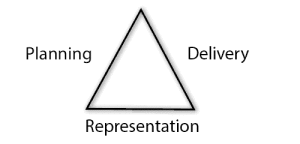My Three Function Model
In last Wednesday’s post about how to use models, I promised this time I would introduce my key three function model. I’ve found it simple to use and effective. How do you use it? You find out where and how these three functions are taking place in your neighbourhood.
No two places are the same and you find sometimes several organisations share a single function or it is absent. Sometimes one organisation is responsible for all three. Once you know who is responsible for these three functions, you can find out how they work together.
In general, I seek a clear separation between these roles, encouraging them to be delivered from different organisations. However, some organisations are able to carry out all three and if that is what is happening, the next step is to ask how it’s working and how to improve the ways in which they interact. It is usually not a good idea to impose changes so the model fits better, remember all models are descriptive, not prescriptive.
The Three Functions
- I usually put Representation along the base of the triangle because it is the foundation for everything else. You need some means of bringing people together and helping them discuss and develop their ideas.
- Planning is an activity distinct from representation and so do not confuse the two. Planning is a partnership activity. If partners are not present, you are not planning. What you are probably doing, and this accounts for the confusion, is preparing for your planning. If you are going to plan for real change in your area, you need a community plan because all your partners, the local authority, the police, the NHS – whoever they are – will have their own plans. Maybe planning would be better labelled ‘negotiation’ but I insist on leaving it as planning because that is what you do when you sit down with partners who, like you, have their own plans.
- And delivery is implementation of ideas from your planning. If you want lasting change, delivery should emerge from negotiated plans.
Using the Three Function Model
The power of this model is in the way you circle it. Circle clockwise and it is a development process. So,
- Representation feeds ideas into planning.
- Planning designs projects for delivery.
- Strengthen representation through participation in delivery.
Circle anti-clockwise and you have accountability. So,
- The representative body evaluates delivery, perhaps by providing feedback to the delivery bodies (or voting with their feet!)
- Delivery bodies bring a realistic appraisal of what is possible to the planning process. They will have insights into what is and is not possible in a particular neighbourhood.
- The partners in the planning process validate the representative body. The extent to which they address local plans, and recognise the representative body can validate or challenge its claims to be representative.
Either of these flows can be blocked in various ways and the development worker’s challenge is to name blockages and help others see them too. That should keep you busy!
Can you think of examples where you can apply this model? What did you learn and how did it help?

